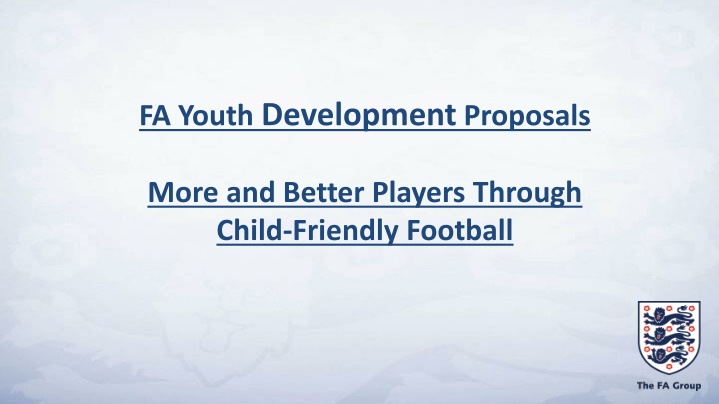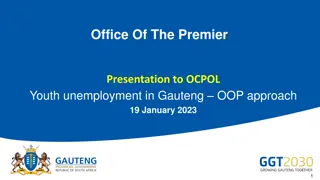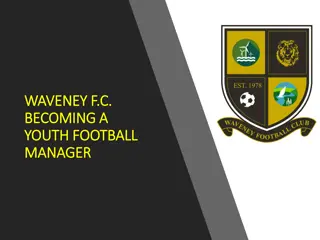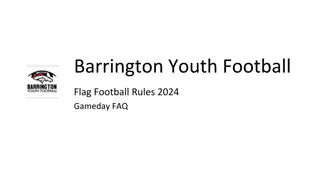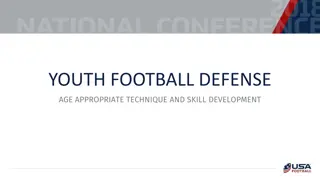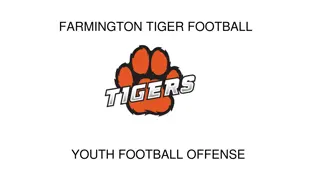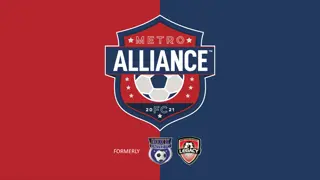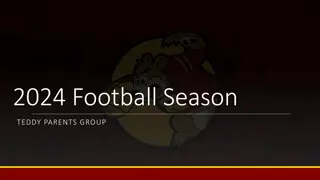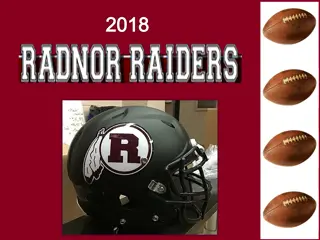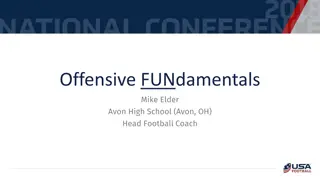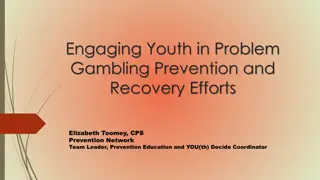Enhancing Youth Football Development Strategies for Better Players
The FA has outlined proposals to improve youth football development, focusing on child-friendly approaches and maximizing player enjoyment. Key principles include implementing a progressive player pathway, utilizing small-sided games, and enhancing coaching strategies. Consultation and research have guided the development of flexible competition formats and key outcomes to enhance player development and participation.
Download Presentation

Please find below an Image/Link to download the presentation.
The content on the website is provided AS IS for your information and personal use only. It may not be sold, licensed, or shared on other websites without obtaining consent from the author.If you encounter any issues during the download, it is possible that the publisher has removed the file from their server.
You are allowed to download the files provided on this website for personal or commercial use, subject to the condition that they are used lawfully. All files are the property of their respective owners.
The content on the website is provided AS IS for your information and personal use only. It may not be sold, licensed, or shared on other websites without obtaining consent from the author.
E N D
Presentation Transcript
FA Youth Development Proposals More and Better Players Through Child-Friendly Football
The FA Group Strategic Plan Delivering the goal of Football for everyone (better players and more people playing). The FA National Game Strategy 2011 - 2015 Focus on development of young players through appropriate coaching and competition to maximise their enjoyment and development. The FA Youth Development Review Delivering Recommendation A and G Format pathway and Relative age effect. Whole Game approach to international team success 2 4 Young player development Elite Player Performance Plan 1 International Team Development 3 Coaching Strategy
Key Principles To implement a progressive, phased and developmental player pathway. The value of small-sided games and flexibility for stakeholders is key to meet today s societal demands. To provide scope for CFA s and other organisations to support transition points remains important for developing better players. To implement a modern and cutting edge approach to competition that puts the learner at the heart. Complement developments in coach education that offer a rich and authentic learning experience for players. Harmonised by The Future Game, outlining key approaches to delivery.
Consultation and Research 16 Regional Your Kids Your Say Roadshows All eight County FA regions, inc. CFA CEO s, CFA Football Development staff Over 300 Youth Leagues Over 1,000 Youth Club Administrators Over 4,000 volunteers and coaches 50 groups of 8-12 year old Children FA National and Regional coaches Premier League and Football League Academy staff Academic books and research articles Football experts and child development experts Other European countries
Formats of the game Flexible Competition Relative Development of Mini- Soccer Age Effect
Key Outcomes Execute clear and structured guidelines on the maximum number of players per team for youth football. Implement a developmental process for playing up at all age groups, supported by rules, to grow and retain participation. Defined role for CFA s to support transition to develop better players. Guidelines for competition structures for U7 U11 age groups. Prohibit 8-month long seasons for U7-U11 children. New approach to competitive football; delivering an educational model to support learning and development. Increase participation by retaining more summer-born children. Deliver against two key National Game Strategy outcomes.
Formats of the Game Format (maximum format but can play smaller numbers) Pitch Size (yards) Maximum Goal Size (feet) Age Ball Size U7 5 v 5 3 30x20 to 40x30 12 x 6 U8 5 v 5 3 30x20 to 40x30 12 x 6 U9 7 v 7 3 50x30 to 60x40 12 x 6 U10 7 v 7 9 v 9 4 4 50x30 to 60x40 70x40 to 80x50 (50x30 to 60x40) 12 x 6 16 x 7 to 21 x 7 (12 x 6) U11 (Primary Schools 7 v 7) (4) U12 9 v 9 4 70x40 to 80x50 16 x 7 to 21 x 7 U13 9 v 9 or 11 v 11 4 90x50 to 100x60 21 x 7 to 24 x 8 U14 9 v 9 or 11 v 11 4 90x50 to 100x60 21 x 7 to 24 x 8 U15 9 v 9 or 11 v 11 5 90x50 to 110x70 24 x 8 U16 9 v 9 or 11 v 11 5 90x50 to 110x70 24 x 8 U17 11 v 11 5 90x50 to 110x70 24 x 8 U18 11 v 11 5 90x50 to 110x70 24 x 8
Formats of the Game: evidence Academic research into value of small-sided games. Technical development benefits Skill acquisition benefits Less players = more touches, simplified tactical environment making game visually clearer for young people. Feedback from children. Why do I have to defend a goal the same size of Petr Cech? (U11, West Riding) Feedback from coaches. Quality movements at higher intensity levels providing more physiological benefit as part of long-term player development
Formats of the Game: phasing-in process Season 2013/14 (maximum format but can play smaller numbers) Under 7 s 5 v 5 Under 8 s 7 v 7 Under 9 s 7 v 7 Under 10 s 7 v 7 Under 11 s 9 v 9 Youth Clubs Under 12 s Optional 9 v 9 or 11 v 11 Under 13 s 11 v 11 Season 2014/15 (maximum format but can play smaller numbers) Under 7 s 5 v 5 Under 8 s 5 v 5 Under 9 s 7 v 7 Under 10 s 7 v 7 Under 11 s 9 v 9 Youth Clubs Under 12 s 9 v 9 Under 13 s Optional 9 v 9 or 11 v 11 Season 2015/16 (maximum format but can play smaller numbers) Under 7 s 5 v 5 Under 8 s 5 v 5 Under 9 s 7 v 7 Under 10 s 7 v 7 Under 11 s 9 v 9 Youth Clubs Under 12 s 9 v 9 Under 13 s Optional 9 v 9 or 11 v 11
Flexible Competition From 2013/14, child-friendly competition only at U7, U8 and U9 From 2014/15, child-friendly competition only at U7, U8, U9 and U10 From 2015/16, child-friendly competition only at U7, U8, U9, U10 and U11 Provides variety in the competition programme. Ownership and flexibility for Youth Leagues. Focus on learning the game, without pressure of win-at-all costs. Focus on periods of development matches, interspersed with competition. No focus on league tables and no three points every week. Learning to win still important but in an age-appropriate context. New process will actually increase competition for more teams.
Flexible Competition: evidence Academic research indicates over-competitive focus leads to increased pressure and increased drop out from the game. The win-at-all-costs culture is stifling development, learning and enjoyment. Feedback from children. If we win, my dad lets me stay up late, if we lose he makes me go to bed early (U11, Liverpool) I don't like it when we try something new and it doesn't go right first time and the adults shout at me (U10, Worcestershire) Feedback from coaches. There is too much pressure on the children to have to win, the parents have changed attitude now we are U9 and are desperate to win which affects the boys (U9 coach, Sussex)
Flexible Competition Current Model One season from September to April Three Mini Seasons One division: One-day knockout competition Handicap system for the teams Top half/Bottom half competition Round Robin three-way competition Futsal finals day Development matches learning the game
Flexible Competition Current Model One season from September to April Three Mini Seasons Multi divisions: One-day knockout competition World Cup / Champions League format Cup / Vase / Shield events for all teams Bottom three from A in with top 3 from B Chance to see ability of teams in different divisions against each other Development matches learning the game
Flexible Competition: Phasing-in Process Season 2013/14 Season 2014/15 Season 2015/16 Season 2016/17 Under 7 s Flexible Competition Under 7 s Flexible Competition Under 7 s Flexible Competition Under 7 s Flexible Competition Under 8 s Flexible Competition Under 8 s Flexible Competition Under 8 s Flexible Competition Under 8 s Flexible Competition Under 9 s Flexible Competition Under 9 s Flexible Competition Under 9 s Flexible Competition Under 9 s Flexible Competition Under 10 s Leagues Tables Under 10 s Flexible Competition Under 10 s Flexible Competition Under 10 s Flexible Competition Under 11 s Leagues Tables Under 11 s Leagues Tables Under 11 s Flexible Competition Under 11 s Flexible Competition Under 12 s Leagues Tables Under 12 s Leagues Tables Under 12 s Leagues Tables Under 12 s Leagues Tables
Relative Age Effect Split the selection year to have two bias points: School football September to August (no change) Youth football January to December Ensure the pitch guidelines are appropriate to age of the child playing the game. Education - Make more people aware of the issue so the selection field doesn t have a bias from the start.
Relative Age Effect: evidence Academic research indicates: Over-emphasis on September to December born-children in school, club and academy football teams. Summer-born children not entering talented and gifted systems Greater drop-out of children born in quarter 4 at every age group U8-U16 Feedback from Scottish FA having made the change increased retention of summer-born children in club football (SYFA National Secretary) Institute of Fiscal Studies state: the economic consequences facing summer babies will last throughout their working lives. ...with August-born teenagers 20% more likely to be in vocational rather than academic study after school. (2011 Report)
Relative Age Effect: Phasing-in Process Season 2013/14 2007 s Season 2014/15 2008 s Season 2015/16 2009 s Season 2016/17 2010 s Season 2017/18 2011 s Under 8 s 2007 s 2008 s 2009 s 2010 s Under 9 s Under 9 s 2007 s 2008 s 2009 s Under 10 s Under 10 s Under 10 s 2007 s 2008 s Under 11 s Under 11 s Under 11 s Under 11 s 2007 s
Mini-Soccer Use the half way line for the opposition to drop off to so teams can play out from the back through Mini-Soccer (U7-U10). Introduce optional four s instead of mandatory 2 s. Introduce optional roll-ins or throw-ins for U7 and U8 children. Best practice recommendation of a minimum 50% playing time for every child.
Timescales January March June September December 2011 2012 2013 2014 Ongoing Consultation Jan - September 2011/2012 Season No Changes 2012/2013 Season Optional 2013/2014 Season Mandatory
The difficulty lies not in the new ideas but escaping from the old ones (John Maynard Keynes)
Summary of Recommendations 1. To implement the revised player pathway. 5 v 5, 7 v 7, 9 v 9, 11 v 11 2. To implement a child-centred competition programme Focus on development and enjoyment 3. To implement an intervention programme for Relative Age Effect Retention of players in the game
